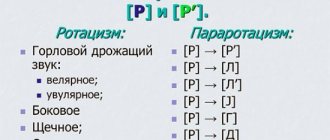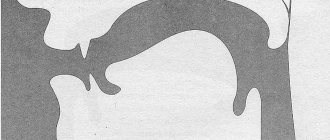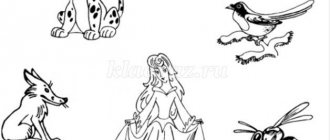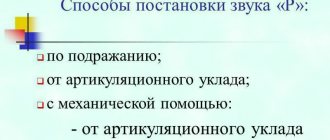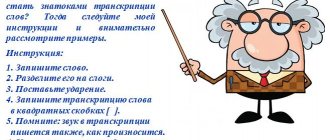When articulating the sound [g]
- The lips take the position of the next sound.
- The distance between the incisors depends on the vowel following r.
- The tip of the tongue is lowered and does not touch the lower incisors. The front and middle parts of the back of the tongue are lowered, the back of the back of the tongue forms a bridge with the palate. The lateral edges of the tongue are pressed against the upper molars.
- The soft palate is raised and pressed against the back wall of the pharynx, thus the passage into the nasal cavity is closed, the air stream goes through the mouth.
- The vocal folds close and vibrate at the moment preceding the explosion of the closure between the tongue and palate as a result of the passage of the exhaled stream of air. A ringing, hard sound is produced [g].
When articulating the sound [k]
- The lips are in the position following the k vowel, not tense.
- The distance between the incisors depends on the vowel following k.
- The tip of the tongue is lowered and does not touch the lower incisors. The anterior and middle parts of the wall of the tongue are lowered, the back part of the wall of the tongue forms a bridge with the palate. The lateral edges of the tongue are pressed against the upper molars.
- The soft palate is raised and closes the passage into the nasal cavity.
- The vocal folds are open. The exhaled stream explodes the closure between the tongue and the palate, resulting in a characteristic noise.
When articulating the sound [k']
The lips stretch a little and reveal the teeth.
The teeth are open up to 5 mm.
The tip of the tongue is lowered and touches the lower incisors. The front part of the tongue is lowered, the middle part of the back of the tongue approaches the hard palate, the tongue moves forward somewhat and makes a bow with the middle part of the hard palate. The lateral edges of the tongue are pressed against the upper molars.
The soft palate is raised and closes the passage into the nasal cavity.
The vocal folds are open. The exhaled stream explodes the closure between the tongue and the palate, resulting in a characteristic noise.
When articulating sound [s]
- Tip of the tongue
rests on the lower front teeth.
- Lips
stretched out, as if smiling, and do not cover the teeth.
- Teeth
close together or closed
- We exhale the air forcefully in the middle of the tongue, along the “groove”; a sharp cold stream is felt on the palm brought to the mouth.
- Vocal folds
open.
- The sound is dull.
PREPARATORY EXERCISES Sound C
Exercises to develop air pressure.
1) We draw air into our lungs, forcefully begin to blow (and not just exhale) it through our lips stretched forward like a “tube”. We control it with the palm of our hand, a piece of paper or cotton wool. We feel a sharply beating cold stream, the piece of paper or cotton wool is deflected to the side. We repeat the exercise.
2) We stick out our tongue so that it rests calmly, without straining, on the lower lip. Place a thin round stick (match) along the tongue to its middle and press lightly to form a groove. We round our lips, but do not strain them. The teeth are open. Inhaling, we forcefully blow out the air, puffing out our cheeks. We control it with the palm of our hand, a piece of paper or cotton wool. We repeat the exercise.
3) We do the previous exercise without using a stick. Lip exercise. We stretch our lips into a smile to the limit and hold them in a tense position for some time. We close our teeth. Repeat the exercise.
Exercise. Pronouncing a long sound s.
1) Open your mouth. Spread your tongue and rest the tense tip against your lower teeth. Place a round thin stick (or match) along the tip of the tongue so that it presses only the front part of the tongue. The lips are stretched into a smile. Close your teeth as far as the stick allows. We forcefully blow out the air evenly, controlling it with the palm of our hand, a piece of paper or cotton wool. A long s— sound is heard. We repeat the exercise.
Note. If the stick is not in the middle of the tongue or the air pressure is insufficient, the sound will be unclear and not whistling.
2) Do the same exercise with slowly removing the stick from the mouth to the teeth and out. We do the exercise several times without using a stick.
When articulating a soft sound
[ With' ]
- lips
slightly stretched into a smile, teeth visible;
- teeth
open by 1-2 mm;
- wide tongue tip
rests on the lower incisors;
- anterior dorsum of tongue
forms a gap with the upper teeth or alveoli; the middle part of the back of the tongue is raised to the hard palate;
- lateral edges of the dorsum of the tongue
tightly pressed to the lateral teeth, a groove is formed along the tongue along the midline;
- in the middle of the tongue
there is a cold stream of air, which is clearly felt with the back of the hand brought to the mouth;
- soft sky
raised, pressed against the back wall of the pharynx, closing the passage into the nasal cavity, the air stream goes through the mouth;
- vocal folds
not tense, apart, the voice is not formed.
Features of the construction of the speech apparatus:
- Power mechanism: diaphragm, lungs, trachea, larynx, oral cavity, nasal cavity
- Vibration mechanism: vocal cords
- Resonator: nasal cavity, oral cavity, pharynx
- Mechanism that forms an obstacle to the passage of air: tongue (tip, anterior, middle, posterior part of the tongue), lips, teeth, soft palate and uvula, hard palate and alveoli.
Rhythm is the combination of stressed and unstressed syllables and the relative speed of their pronunciation.
It is necessary to distinguish between phrasal stress and logical :
Phrase stress - both in Russian and in English, a number of words lose their stress in a sentence (mainly function words, prepositions, conjunctions, pronouns).
Logical stress - unlike phrasal stress, often the main semantic load falls on one word (and even on function words). When the logical stress changes, the sentence changes its purpose, that is, it answers different questions.
The rhythm of English speech is characterized by the fact that stressed syllables follow each other at more or less regular intervals, regardless of the number of unstressed syllables between them, therefore, the more unstressed syllables between two stresses, the faster each of them is pronounced.
In English, two or more stresses are possible within a word, but in Russian there is only one.
Was the article useful? Click on the button below and save it to your social network 
Previous articles
Vowel sounds in different varieties of English
Rules for reading English vowels
Differences between British and American English. Pronunciation
[z]
1. Lips in a smile, teeth visible;
2. The teeth are close together , but not closed;
3. The wide tip of the tongue is located behind the lower incisors;
4. The lateral edges of the back of the tongue are tightly pressed against the lateral teeth, and only in the middle there remains a narrow gap in the shape of a groove;
5. There is an air stream in the middle of the tongue, which is felt with the back of the hand brought to the mouth;
6. The soft palate is raised, pressed against the back wall of the pharynx, closing the passage into the nasal cavity, the air stream goes through the mouth;
7. The vocal folds are tense, brought together and vibrate, resulting in the formation of the voice.
The sound z is placed similarly to the sound “s” and is characterized by additional phonation of the vocal cords.
When articulating the sound [ts]
We start producing the sound ts only if we have good pronunciation of the sounds s, etc. When pronouncing the sound.
- Tip of the tongue
, as when pronouncing the sound s, rests on the front lower teeth. We lift the tongue and bend it “slide”. The front part of the back of the tongue should close with the palate (at the alveoli). The tongue is spread wide, the lateral edges are tense. At the moment of exhalation, the front part of the backrest is instantly disconnected from the palate. We slightly pull the tip of the tongue away from the lower teeth, thereby increasing the push of the air stream.
- Lips
stretch out in a smile.
- Teeth
When pronouncing a sound, we close or bring together. When pronouncing a vowel sound in straight syllables, the teeth open.
- Air
we exhale with a push at the moment the tongue opens with the palate. On the back of the hand, brought to the mouth, a cold stream of air is felt.
- Vocal folds
are open and do not vibrate, therefore a dull sound c is formed.
The sound ts is formed by merging the sounds t and s.
When pronouncing the sound t, the exhaled stream of air is strong with an explosive character, as when pronouncing the sound t, and pronouncing the sound s gives the affricate t a whistling tone. Good pronunciation of the sounds t and s separately does not guarantee quick production of the sound ts by imitation.
PREPARATION EXERCISES
Exercise to develop the pressure of exhaled air. To do this, we insert the tip of the tongue between the teeth. Press the tip with your teeth. We quickly unclench our teeth and forcefully pull the tip of our tongue inward (not too far) simultaneously with the exhalation of air with a push. We hear a hard interlabial sound.
Exercises for the tongue.
1) Open your mouth.
We rest the tip of the tongue against the lower front teeth, and lift and bend the tongue so that the front part is pressed against the palate. The tongue touches the upper teeth with the back. Without turning on the voice, pronounce a sound that imitates the sound t. (When pronouncing an isolated normal sound t, the tip of the tongue rests on the upper front teeth.) The sound is pronounced at the moment of opening, when the tip of the tongue bounces off the lower front teeth under the pressure of a strong stream of exhaled air. We tense our lips and stretch them into a smile. Control of the back of the hand.
The exercise is useful in that we accustom the tongue to the position that is necessary when pronouncing the sound ts. Note. When pronouncing a sound imitating the sound t, the tip of the tongue rests on the upper front teeth (as when pronouncing a hard sound t), and the goal of the exercise is not achieved.
2) Open your mouth.
We press the tip of the tongue tensely against the lower front teeth. The back of the tongue is arched and touches the upper front teeth.
Articulation. Basic Concepts
Category: Phonetics Don't have time to read the article now?
Read it in your free time on your favorite social network - click on the buttons below! In this article we will look at the basic concepts associated with articulation (the joint work of the speech organs necessary to pronounce speech sounds).
Dorsal is a style in which the tip of the tongue is at the base of the lower teeth. The back of the tongue is arched. The place of articulation is at the tip of the tongue and the lower teeth.
Apical is the position in which the tip of the tongue is on the most convex part of the alveoli. The place of articulation is at the tip of the tongue and the convex part of the alveoli.
The place of articulation is where the bow occurs and sound is created.
Pronunciation is the process of clear and correct sound and intonation design of a statement.
Articulation is the position and movements of the speech organs, which in their interaction produce the sounds of the language.
Pronunciation includes concepts such as:
- Intonation (stress, rhythm, timbre, pause, tempo)
- Articulation (speech organs)
- movable (tongue, lips, soft palate)
- motionless (teeth, alveoli, hard palate)
According to the position of the middle part of the back of the tongue in relation to the hard palate.
An additional moment of articulation in the formation of many consonant sounds, which consists in raising the middle part of the back of the tongue to the middle part of the hard palate, gives these sounds a touch of softness. Taking into account this additional moment of articulation, most consonant sounds in the Russian language form soft and hard pairs - 15 pairs in total. These include: P-Пь, Б-Бь, М-Мь, Ф-Фь, В-Вь, Т-ти, Д-дь, Н-Нь, С-Сь, 3-Зь, Р-Рь, Л- L, K-K, G - G, X-X.
The following sounds do not have soft pairs: Ш, Ж, Ц; the sounds Ch, Shch.Y do not have hard pairs.
The sign of hardness and softness of sounds in the Russian language is also meaningful, since depending on the presence or absence of softening of consonants, the meaning of the word radically changes. As in previous cases, this is especially clearly manifested in quasi-homonym words, for example: chalk -mel, corner - coal, MOUSE - BEAR, choir - polecat, circle - hook, Ditch - ROAR, LUK - HATCH, MAL - MYAL, FINGERS - Hoop, NOSE - BEARED, WASPES - AXLES, pole - six, WHIN - THREAD, HOWL - VIT, dust - dust, etc.
It is characteristic that, according to the principle of all the considered semantic distinctions, not only individual pairs of the above words are differentiated, but also entire “chains” of such words, combining several differential features of sounds at once.
For example:
Som - Tom - Com - Scrap - Rum - House - Zhom. Ox - Gol - Dol - Zol - Kol - Mol - Gender - Tol. Pain - Gol - Mol - Salt - Zero - Role - Tol. Kidney - Barrel - Point - Daughter - Lobe - Nochka - Kochka. Muchka - Handle - Heap - Pike - Bug - Cloud. Bunny - Bunny - Mike - Nut - Laika - Bike - Seagull - Gang.
Board - Port - Cake - Court - Sort - Fort. Bor - Thief - Mor - Zhor - Sor - Choir. Will - Share - Kolya - Fields - Tolya. Fat - World - Feast - Shooting Range.
Masha - Dasha - Yours - Ours - Porridge - Sasha - Gasha - Pasha - Bowl
Chick - Bangs - Chink - Shelf - Solka - Withers
The existence of such chains of words once again convinces us of the need to educate children in a very clear auditory-pronunciation differentiation of each sound from similar ones. Otherwise, they will have difficulty both in understanding the interlocutor’s speech and in producing their own statements,
The articulation of each consonant includes all five parameters considered, namely:
1. Any consonant sound is either labial (labial-labial or labial-dental) or lingual (lingual-eubic, lingual-alveolar, lingual-anteropalatal, midlingual, posterior-lingual) depending on the place of formation of the barrier to the air stream during its articulation.
2. Any consonant is either a stop, or a fricative, or a stop-pass, or a tremulous, or an affricate, depending on the method of forming an obstacle to the air stream during its articulation,
3. Any consonant sound is either voiced or voiceless, depending on the participation or non-participation of vocal folds in its formation.
4. Any consonant sound is either nasal or oral, depending on the presence or absence of closure of the velum palatine with the posterior wall of the pharynx during its formation.
5. Any consonant sound is either soft or hard, depending on the presence or absence, during its articulation, of an additional rise of the middle part of the back of the tongue to the middle part of the hard palate.
Thus, when describing the articulation of any consonant sound, it must be characterized according to all the five parameters mentioned above.
For example, the sound B is labiolabial (according to the place of formation), stop (according to the method of formation), hard (according to the additional rise of the middle part of the back of the tongue). oral (via the participation of the velum). voiced (due to the participation of gopo folds),
The sound Cb is anterior lingual (according to the place of formation), fricative (according to the method of formation), soft (according to the additional rise of the middle part of the back of the tongue), oral (according to the participation of the velum palatine), voiceless (according to the participation of the vocal folds).
If we talk about the normal articulation of sounds from a speech therapy point of view, that is, from the point of view of educating normal articulations, then the articulation of each consonant sound must be learned in the following sequence (starting with the visible parts of articulation):
- lip position;
— distance between incisors;
- the position of the tongue (its tip, middle and posterior parts of the back, lateral edges), as well as the formation of a gap or closure with other articulatory organs by these parts of the tongue;
- position of the soft palate (presence or absence of its closure with the posterior wall of the pharynx);
- position of the vocal folds: (closed and vibrate or open)
closed);
In order to facilitate memorization, each of these moments of articulation can be presented in a generalized form, that is, immediately in relation to all consonant sounds.
Lip position
The lips should occupy a very specific position when articulating the following sounds:
- labial P (Pb), B (Bb), M (Mb), during the formation of which they
closed;
- labial-dental F (b), B (Bb), during the formation of which a gap is formed between the lower lip and upper incisors;
- whistling sounds S (Сь), 3 (Зь), Ц, and also И, during the formation of which the lips are spread apart and are in a half-smile position;
- hissing Ш, Ж, Ш, Ш, during the formation of which the lips are rounded and protruded forward and are in the “horn” position. When forming all other consonant sounds, the lips occupy a neutral position, that is, they do not participate in the formation of sounds
Teeth position
A certain distance between the upper and lower incisors (from 1 to 2 mm) must be ensured during the formation of whistling and hissing sounds, as well as the sound Y, that is, the following consonant sounds: C (Сь), 3 (Зь), Ц; Sh, F, Ch, Sh; Y.
The teeth do not participate in the pronunciation of all other consonant sounds and occupy a neutral position.
Tongue position
Regarding the position of the tongue, it is important to know the following basic points that are important for developing normal articulation of consonant sounds:
1. When almost all consonant sounds are produced, the tongue is wide and its lateral edges touch the molars, preventing the “lateral” passage of exhaled air. The only exceptions in this regard are the sounds L, L, during the pronunciation of which the tongue is narrow and the exhaled air passes between the molars and the lateral edges of the tongue.
2. The tip of the tongue is located at the upper or lower front teeth during the formation of anterior lingual sounds, which include the sounds T (Ть), Д (Дь), Н (Нь), Л (Ль) (tip of the tongue at the upper incisors) and С (Сь ), 3 (Зь), Ц, И (tip of the tongue at the lower incisors).
3. The tip of the tongue is located at the upper alveoli during the formation of the ovular-alveolar sounds P and Pb.
4. The tip of the tongue is located at the anterior edge of the hard palate during the production of lingual-anteropalatal sounds, which include the hissing Ш, Ж, Ш, Ш.
5. The middle part of the back of the tongue is raised to the hard palate during the formation of middle lingual sounds, which include the sounds Y, Kb, Gb, Xb.
6. The back part of the back of the tongue (its root) is raised to the hard palate during the formation of the posterior lingual sounds K, G, X.
Position of the soft palate
During the formation of almost all consonant and vowel sounds, the soft palate is raised and closes with the back wall of the pharynx, preventing air from escaping through the nasal cavity and thereby “protecting” all these sounds from the nasal connotation. The only exceptions are the nasal consonants M (Мь) and Н (Нь), during the formation of which the soft palate is lowered and the passage into the nasal cavity is open.
Vocal fold position
When all voiceless consonants are formed (these include both voiceless sounds from the above-mentioned six pairs of consonants - P (Пь), Т (ть), К (Кь), Ф (ь), С (Сь), Ш, and not Having voiced pairs of consonants Ts, Ch, Shch, X (Хь), the vocal folds are open and do not vibrate.
When all voiced consonants are formed (they include both voiced sounds from the six mentioned pairs of consonants - B (Бь), Д (Дь), Г (Гь), В (Вь), 3 (Зь), Ж, and those without voiceless pairs of consonants P (Рь), Л (Ль), М (мь), Н (Нь), И) the vocal folds are closed and vibrate, due to which a voice is formed and sounds acquire sonority.
It is important to take into account that if at least one of all the conditions for the articulation of consonant sounds discussed above is not fulfilled or accurately fulfilled, they sound abnormal, which means that in such cases we are dealing with defects in sound pronunciation, many of which relate to dyslalia.
As a rule, with dyslalia, the pronunciation of only consonant sounds is impaired, while vowel sounds are pronounced correctly. However, it is important to know the normal articulation of these sounds as well. In Russian there are 6 of them - A, O, 'U, E, Y, I.
Normal articulation of vowel sounds
It is much more difficult to characterize than consonants, since they do not have an exact localized place of formation. When pronouncing vowels, there is tonic tension on all the roof walls of the resonators in the absence of a local obstacle to the path of exhaled air. Therefore, the differential features of vowels compared to consonants are much less distinct.
By method of education,
due to the absence of barriers, all Russian vowels are of the same type - the vocal-exhalatory stream passes unhindered through the oral cavity.
Vowel sounds differ only in the participation in their formation of the main articulatory organs - the tongue and lips.
With regard to the position of the tongue in phonetics, it is customary to distinguish two main differential features - row and rise.
The concept of a row indicates which part of the tongue (front, middle or back) is predominantly involved in the formation of sound. For example, with I and E, mainly the front part of the tongue is raised, and with O and U, the back part is raised. The gradual movement of articulation in the front-to-back direction can be traced when pronouncing the vowels I-Y-U sequentially.
The concept of elevation indicates the degree of elevation of the anterior, middle or posterior part of the tongue. So, with A the tongue lies calmly at the bottom of the mouth (low vowel), with O it is raised to an average height (middle vowel), and with U it is even higher (high vowel). - Classification of words according to rows and rises is possible presented in the form of a table like this:
| Climb | Row | ||
| Front | Average | Rear | |
| Upper Middle Lower | I E - | Y A | U O - |
The lips are actively involved in the formation of labialized vowels - with O they are slightly rounded, and with U they are pushed forward. When And the lips are slightly stretched into a smile.
The soft palate is raised during the formation of all vowels, since they are all oral.
the vocal folds are closed and vibrate, since they are all formed with the participation of the voice.




